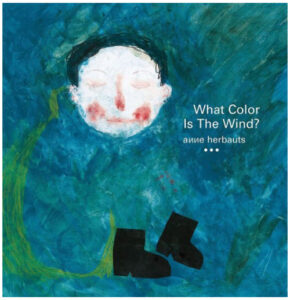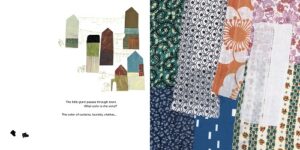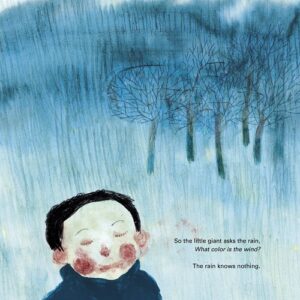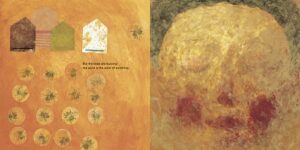 What Color Is the Wind?
What Color Is the Wind?
By Anne Herbauts
Translated by Claudia Zoe Bedrick
Enchanted Lion Books
$19.95
ISBN: 978-1-59270-221-3
Ages 5 and up
On shelves now
I’m going to have a hard time of it when my kids grow up. When I had them I swore up, down and sideways that I wouldn’t turn into the kind of blogger that declares that a book is good or bad, based solely on the whims of my impertinent offspring. For the most part, I’ve kept that promise. I review picture books outside of their influence, though I’m always interested in their opinions. Indeed, these opinions, and the sharp eyes that inform them, are sometimes not what I’d expect at all. So while I’ve never changed my opinion from liking a book to not liking it just because it didn’t suit my own particular kids’ tastes, I have admittedly found a new appreciation for other books when the children were able to spot things that I did not. What Color Is the Wind? is a pretty good example of this. I read the book at work, liked it fine, and brought it home for a possible review. My daughter then picked it up and proceeded to pretty much school me on what it contained, front to finish. Had I noticed the Braille on the cover? No. Did I see that the main character’s eyes are closed the whole time? No. How about the tactile pages? Did you notice that you can feel almost all of them? No. For a book that may look to some readers as too elegant and sophisticated to count as a favored bedtime story, think again. In this book Anne Herbauts proves beyond a shadow of a doubt that a distinct European style is engaging to American children when their parents give it half a chance. Particularly when tactile elements are involved.
 “We can’t see the wind, / we hear what it brings. / We can’t hear the wind, / we see what it brings.” The book begins with a question. A boy, his eyes closed, walks behind the cutout of a house. “What color is the wind? asks the little giant.” As he walks along, various plants, birds, animals, and inanimate objects offer answers. A wolf says the wind’s color is “the dark smell of the forest” while a window disagrees and says it’s “the color of time.” Everything that answers the little giant has a different feel on the page. The stream feels like consecutive ripples emanating from a dropped pebble, the roots of an apple tree like long, thin rivulets. At last the little giant encounters something that he senses is enormous. He asks his question and an enormous giant replies, “It is everything at once. This whole book.” He flips the book’s pages with his thumb so that they fly, and you the reader do the same, feeling the wind the book is capable of producing with its thick, lustrous pages. The color of the wind. The wind of this book.
“We can’t see the wind, / we hear what it brings. / We can’t hear the wind, / we see what it brings.” The book begins with a question. A boy, his eyes closed, walks behind the cutout of a house. “What color is the wind? asks the little giant.” As he walks along, various plants, birds, animals, and inanimate objects offer answers. A wolf says the wind’s color is “the dark smell of the forest” while a window disagrees and says it’s “the color of time.” Everything that answers the little giant has a different feel on the page. The stream feels like consecutive ripples emanating from a dropped pebble, the roots of an apple tree like long, thin rivulets. At last the little giant encounters something that he senses is enormous. He asks his question and an enormous giant replies, “It is everything at once. This whole book.” He flips the book’s pages with his thumb so that they fly, and you the reader do the same, feeling the wind the book is capable of producing with its thick, lustrous pages. The color of the wind. The wind of this book.
The Kirkus review journal said that this book was, “ ‘The blind men and the elephant’ reworked into a Zen koan” and then proceeded to recommend it for 9-11 year-olds and adults. I’m fairly certain I disagree with almost every part of that. Now here’s the funny part. I didn’t read this review before I read the book. I also didn’t read the press release that was sent to me with it. When I read a book I like to be surprised by it in some way. This is usually a good thing, but once in a while I can be a bit dense and miss the bigger picture. As I mentioned before, I completely missed the fact that this book was an answer to a blind child who had asked Anne Herbauts the titular question. I just thought it was cool that the book was so much fun to touch. Embossing, debossing, die-cuts, lamination, and all kinds of surfaces give the book the elements that make it really pop. As I read it in the lunchroom at work, my co-workers would peer over my shoulders to coo at what they saw. All well and good, but would a kid be interested too? Kirkus says they’d have to be at least nine to grasp its subtleties.
 Obviously my 5-year-old daughter likes the book but she’s just one kid. She is not a representative for her species (so to speak). That said, this book just drills home the advantage that physical books have over their electronic counterparts: the sensation of touch. Play with a screen all day if you like, but you will never be able to move your fingers over these raised dots of rain or the rough bark of a tree’s trunk. As children become more immersed in the electronic, they become more enamored of tactile books. The sensation of paper on skin has yet to be replicated by our smooth as silk screens. And this will prove true with kids on the younger end of the scale. I’ll agree with Kirkus about the adult designation, though. When I worked for New York Public Library there was a group of special needs adults that would come in that were in need of tactile picture books. We would be asked if we had any on hand that we could hand over to them in some way. There were a few, but our holdings were pretty limited (though I do remember a particularly keen tactile version of The Very Hungry Caterpillar that proved to be a big hit). Those kids would have loved this book, but children of all ages, and all abilities, would feel the same way about it. Kids are never too old for tactile picture books. As such, you could use this book with Kindergartners as well as fifth graders. Little kids will like the fun pictures. Older kids may be inspired by the words as well.
Obviously my 5-year-old daughter likes the book but she’s just one kid. She is not a representative for her species (so to speak). That said, this book just drills home the advantage that physical books have over their electronic counterparts: the sensation of touch. Play with a screen all day if you like, but you will never be able to move your fingers over these raised dots of rain or the rough bark of a tree’s trunk. As children become more immersed in the electronic, they become more enamored of tactile books. The sensation of paper on skin has yet to be replicated by our smooth as silk screens. And this will prove true with kids on the younger end of the scale. I’ll agree with Kirkus about the adult designation, though. When I worked for New York Public Library there was a group of special needs adults that would come in that were in need of tactile picture books. We would be asked if we had any on hand that we could hand over to them in some way. There were a few, but our holdings were pretty limited (though I do remember a particularly keen tactile version of The Very Hungry Caterpillar that proved to be a big hit). Those kids would have loved this book, but children of all ages, and all abilities, would feel the same way about it. Kids are never too old for tactile picture books. As such, you could use this book with Kindergartners as well as fifth graders. Little kids will like the fun pictures. Older kids may be inspired by the words as well.
“Mom,” said my daughter as we went down the stairs for her post-reading, pre-brushing, nighttime snack. “Mom, you know the wind doesn’t have a color, right?” My child is a bit of a literalist. She’s the kid who knew early on that magic wasn’t real and once told me at the age of three that, “If ‘please’ is a magic word, it doesn’t exist.” So to read an entire book, based on the premise of seeing a color that couldn’t possibly be real, was a stretch for her. Remember, we read this entire book without really catching on that the little giant was blind. I countered that it was poetry, really. Colors were just as much about what they looked like as what they felt like. I asked her what blue made her feel, and red. Then I applied that to the emotions we feel about with the wind, which wasn’t really an analogy that held much water, but she was game to hear me out. “It’s poetry”, I said again. “Words that make you feel something when you read them.” So, as she had her snack, she had me read her some poetry. We’ve been reading poetry with her snack every night since. So for all that the book could be seen to be a straightforward picture book, to me it’s as much an introduction to poetry as anything else.
As for the art, I’ll admit that the combination of the style of art, the image on the cover, and the fact that the book is softcover and not hardcover (a cost-saving measure for what must be a very expensive title for Enchanted Lion Books to publish) did not immediately appeal to me. There’s no note to explain what the medium is and if I were to guess I’d say we were looking at crayons, mixed media, thick paints, colored pencils, ink blots, pen-and-inks, and more. Ironically, I really began to gravitate to the art when the little giant wasn’t stealing my focus. Nothing is intricately detailed, except perhaps the anatomy of honeybees or the raised and bumpy parts of the book. At the same time, for a book that celebrates touch, poetry, and physical sensation, the colors are often bright and lush. Whether it’s the blue watercolors of rain over trees or the hot orange that emanates from the page like a sun, Herbauts is simultaneously rendering illustrations obsolete with the unique format of What Color is the Wind? and celebrating their visual extremes.
I tend to give positive reviews to books that exceed my expectations. That’s just the nature of my occupation. And while I do believe that there are elements to this book that could be clearer or that there must have been a book jacket choice they could have chosen that was more appealing than the one you see here, otherwise I think this little book is a bit of a wonder. Deeply appealing to children of all ages, to say nothing of the adults out there, with so many uses, and so many applications. It reminds me of the old picture books by Bruno Munari that weren’t afraid to try new things with the picture book format. To get a little crazy. I don’t think we’ll suddenly see a big tactile picture book craze sweep the nation or anything, but maybe this book will inspire just one other publisher to try something a little different and to take a risk. Could be worth it. There’s nothing else like this book out there today. More’s the pity.
On shelves now.
Source: Final edition sent from publisher for review.
Like This? Then Try:
- Daniel Finds a Poem by Micha Archer
- The Sound of Colors by Jimmy Liao
- The Black Book of Colors by Menena Cottin
Professional Reviews:
Misc: A deeper look at some of the art over at Seven Impossible Things Before Breakfast




I’m actually delighted that you sometimes use your children as readers. Every now and then I read a bunch of reviews for a book that adults are enchanted by–maybe the illustrations remind them of books when they were younger, or a particular moral is being taught, or the artist is particularly sophisticated and original…I order the book, read it to children, and receive a universal, “Huh?”
Of course there are books that really only work for a few kids, but the universal “Huh?”–where not one hand goes up, asking to check it out–always makes me wish I had my money back. If I had my way, every picture book would be taken to a school or day-care center and tried on kids before it’s published.
Agreed. And it’s been a real blow to my reviews, in a way, that I don’t have daily interactions with large groups of children anymore. In lieu of that I had to make a couple of my own. Still, two is not a representative sample so I hold myself back on using them too too often.